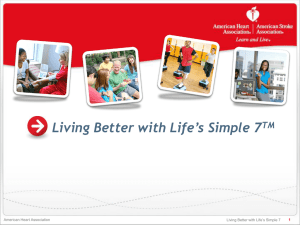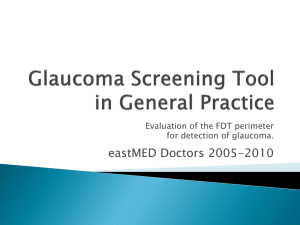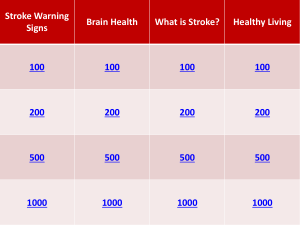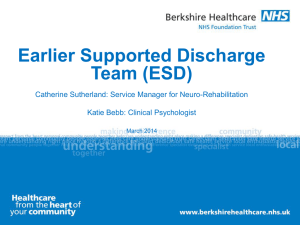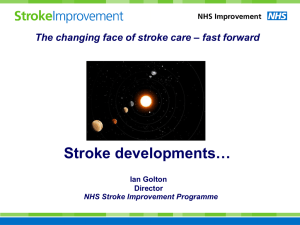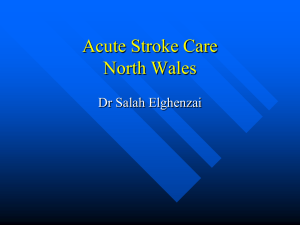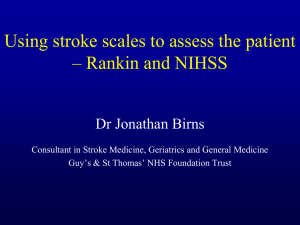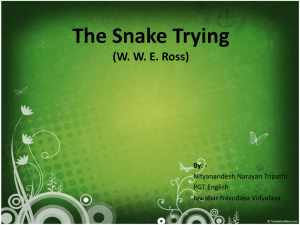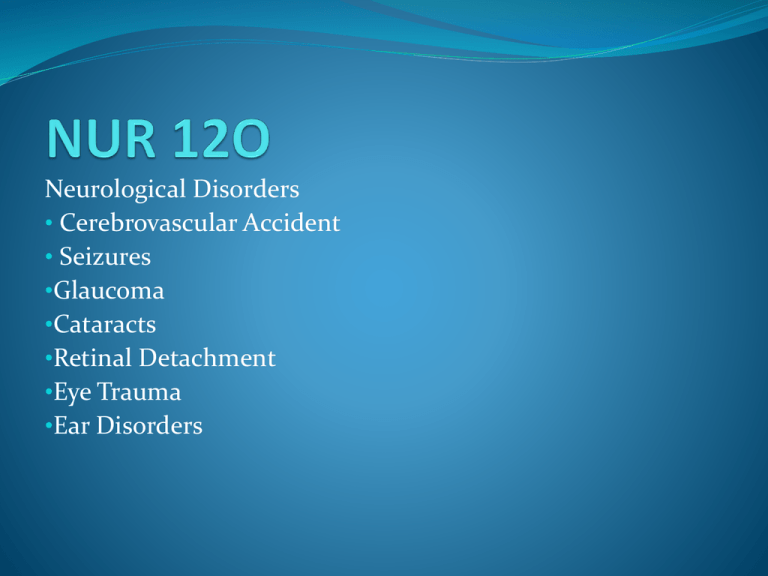
Neurological Disorders
• Cerebrovascular Accident
• Seizures
•Glaucoma
•Cataracts
•Retinal Detachment
•Eye Trauma
•Ear Disorders
The Brain and its lobe/functions
The cerebrum or cortex is the largest part of the
human brain, associated with higher brain function
such as thought and action.
Frontal Lobe- associated with reasoning, planning,
parts of speech, movement, emotions, and problem
solving
Parietal Lobe- associated with movement,
orientation, recognition, perception of stimuli
Occipital Lobe- associated with visual processing
Temporal Lobe- associated with perception and
recognition of auditory stimuli, memory, and speech.
The Brain and its lobe functions
Right hemisphere is associated with creativity and the
left hemispheres is associated with logic abilities. The
corpus callosum is a bundle of axons which connects
these two hemispheres.
The Cerebellum - This structure is associated with
regulation and coordination of movement, posture,
and balance.
Limbic System - referred to as the "emotional brain",
is found buried within the cerebrum. This system
contains the thalamus, hypothalamus, amygdala, and
hippocampus.
The Brain and its lobe/functions
Brain Stem - Underneath the limbic system is the brain
stem. This structure is responsible for basic vital life
functions such as breathing, heartbeat, and blood pressure.
The Amygdala
It's name is latin for almond which relates to its shape. It
helps in storing and classifying emotionally charged
memories. It plays a large role in producing our emotions,
especially fear. It's been found to trigger responses to
strong emotion such as sweaty palms, freezing, increased
heart-beat/respiration and stress hormone release.
Cerebrovascular Accident
Also known as stroke
Involve a disruption in cerebral blood flow related to
ischemia, hemorrhage or embolism.
Stroke affects 700,000 people every year and 160,000
Americans die of stroke each year
Stroke is the sudden stoppage of blood flow.
Description
Sudden loss of brain function resulting from a
disruption in the blood supply to a part of a brain.
CLASSIFICATION:
Thrombotic
Hemorrhagic
CNS involvement related to cause of CVA
Hemorrhagic – cause by a slow or fast hemorrhage into
the brain tissue into the brain tissue: often related to
hypertension.
Embolytic – caused by a clot that has broken away
(embolus) from a vessel and has lodge in one of the
arteries of the brain, blocking blood supply. It is often
related to atherossclerosis.
CVA Pathophysiology
Brain cells need oxygen and nutrients to work properly.
This nourishment is provided from blood flowing
through vessels in the brain.
When one of these vessels becomes clogged by a clot,
or breaks open, the blood flow is suddenly stopped
and the brain cells die.
This is a stroke.
Cerebrovascular Accident
Risk Factors
Hypertension
Atherosclerosis
Hyperlipidemia
Diabetes Millitus
Cocaine Use
Atrial fibrillation
Smoking
Use of Oral Contraceptives
Obesity
Hypercoagilability
Cerebral Aneurysm
Arteriovenous Malformation
What risk factors for stroke can't be changed?
Age — The chance of having a stroke approximately doubles for
each decade of life after age 55.
Heredity (family history) and race — Stroke risk is greater if a
parent, grandparent, sister or brother has had a stroke.
African Americans have a much higher risk of death from a
stroke than Caucasians do.
This is partly because blacks have higher risks of high blood
pressure, diabetes and obesity.
Sex (gender) — Stroke is more common in men than in
women.
More men than women will have a stroke in a given
year. However, more than half of total stroke deaths occur in
women.
Use of birth control pills and pregnancy pose special stroke risks
for women.
Prior stroke, TIA or heart attack — The risk of stroke for
someone who has already had one is many times that of a person
who has not.
What stroke risk factors can be changed, treated
or controlled?
High blood pressure — High blood pressure is the leading
cause of stroke and the most important controllable risk factor
for stroke.
Cigarette smoking - The nicotine and carbon monoxide in
cigarette smoke damage the cardiovascular system. The use of
oral contraceptives combined with cigarette smoking greatly
increases stroke risk.
Diabetes mellitus — Diabetes is an independent risk factor for
stroke.
Carotid or other artery disease — The carotid arteries in the
neck supply blood to the brain. A carotid artery narrowed by
fatty deposits from atherosclerosis may become blocked by a
blood clot. Carotid artery disease is also called carotid artery
stenosis.
Peripheral artery disease is the narrowing of blood vessels
carrying blood to leg and arm muscles. It's caused by fatty
buildups of plaque in artery walls.
Other contributing factors
Atrial fibrillation —The heart's upper chambers quiver instead of beating
effectively, which can let the blood pool and clot.
Sickle cell disease (also called sickle cell anemia) — This is a genetic
disorder that mainly affects African-American and Hispanic children. These
cells tend to stick to blood vessel walls, which can block arteries to the brain
and cause a stroke.
High blood cholesterol — People with high blood cholesterol have an
increased risk for stroke.
Poor diet — Diets high in saturated fat, trans fat and cholesterol can raise
blood cholesterol levels. Diets high in sodium (salt) can contribute to
increased blood pressure.
Physical inactivity and obesity — Being inactive, obese or both can increase
your risk of high blood pressure, high blood cholesterol, diabetes, heart disease
and stroke.
What are other, less well-documented risk factors?
Socioeconomic factors — There's some evidence that strokes are more
common among low-income people than among more affluent people.
Alcohol abuse — Alcohol abuse can lead to multiple medical complications,
including stroke.
Drug abuse Drugs that are abused, including cocaine, amphetamines and
heroin, have been associated with an increased risk of stroke. Strokes caused
by drug abuse are often seen in a younger population.
Diagnostic Procedures
-
Magnetic Resonance Imaging
CT scan
Used to identify edema, ischemia and necrosis.
MR Angiography or Cerebral Angiography – used to
identify the presence of cerebral hemorrhage, abnormal
vessel structures, vessels ruptures, and regional perfusion
of blood flow to the brain.
Lumbar Puncture- is used to assess for presence of blood in
the cerebrospinal fluid.
Carotid Endarterectomy – performed to open the artery by
removing atheroscleroyic plaque.
Interventional radiology is performed to treat cerebral
aneurysm.
Assessments:
Symptoms will vary based on the area of the brain that is
adequately supplied with oxygenated blood.
The left cerebral hemisphere is responsible for language,
mathematic skills, and analytic thinking.
- aphasia (language use or comprehension difficulty)
- Alexia (reading difficulty) loss of ability to read
- Agraphia (writing difficulty) loss of ability to write
- Apraxia – inability to perform purposeful movement
- Right hemiplegia or hemiparesis
- Slow cautious behavior
- Depression and quick frustration
- Visual changes such ashemianopsia ( one side/eye
unable to see.
- Dysphagia – dysfunctional swallowing
Assessments:
He right hemisphere is responsible for visual and
spatial awareness and proprioception.
- unawareness of deficits (neglect syndrome,
overestamation of abilities.
- Loss of depth perception
- Impulse-control difficulty
- Disorientation
- Poor judgment
- Left hemiplegia or hemiparesis
- Visual changes, such as hemianopsia
Location of Disruption in the Brain
Feature
Left Hemisphere
Right Hemisphere
Language
Aphasia
Agraphia
May be alert and oriented
Memory
No Deficit
Disoriented
Cannot recognize faces
Vision
Unable to discriminate words Visual/* spatial deficits
and letters
Neglect of left visual fields
Reading problems
* Loss of depth perception
Deficit in right visual field
* Behavior
* Slow, cautious, anxious
when attempting new
task, Depression or
catastrophic response to
illness, sense of guilt,
feeling of worthlessness,
worries over future, quick
anger and frustration
Impulsive, unaware of
neurologic deficits,
confabulates, euphoric,
constantly smiles, denies
illness, poor judgment,
overestimates abilities,
impaired sense of humor
Hearing
No deficit
Loses ability to hear and
tonal variations
Assess and Monitor:
Nursing Assessment
A.
B.
C.
D.
E.
F.
G.
Change in level of consciousness
Paresthesia, paralysis
Aphasia, agraphia,
Memory Loss
Visual Impairment
Bladder and Bowel dysfunction
Behavioral chnages
Airway patency
Swallowing ability/aspiration risk
Level of consciousness
Neurological status
Motor function
Sensory function
Cognitive function
Glasgow Coma scale score
Assessment of client’s functional abilities
Mobility
Activity of daily living
Elimination
Communication
Ability to swallow, eat, and drink without aspiration
Stroke Assessment
National Institutes of Health Stroke Scale
NIHSS
Developed in 1983 by NIH stroke research neurologists
A Systematic tool designed to measure neuro
deficits most often seen with stroke
Designed to standardize and document
reliable and valid neuro exam
NIHHS Stroke Scale
Need to be trained and certified to perform 11 items
Less than 10 minutes to perform
Range of scores 0 – 42
Lower score indicate less impairment
Score reflects what the patient does!!!
NIHSS Stroke Scale
Helps to determine level of stroke severity
Get points for deficits
0 -1 Normal
1 - 4 Minor Stroke
5 - 15 Moderate Stroke
15 - 20 Moderately Severe Stroke
> 20 Severe Stroke
NIHSS Scale
Predicts outcome
<14 there is a 80% good outcome
>20 there is a 20% good outcome
Aids in planning rehabilitation needs
≥ 14 Severe: long term care
6 – 13 Adequate: acute inpatient rehab
≤ 5 Mild: 80% discharged home
NIHSS Stroke Scale
Assessment Process
General Instructions
Administer items in order listed
Follow directions for each exam
Do not coach patient
Record first answers after each subscale exam
Do not go back and change scores
1a. LOC
1b. LOC Questions
1c. LOC Commands
2. Best Gaze
3. Visual fields
4. Facial palsy
5. Motor Arm
6. Motor Leg
7. Limb ataxia
8. Sensory
9. Best Language
10. Dysarthria
11. Extinction & Inattention
NIHSS Stroke Scale
Level of Consciousness
Arousal
0 = Alert
1 = Not alert, but arousable
2 = Not alert, repeated stimulation
3 = Responds only with reflex motor to noxious stimuli
LOC Questions
Awareness
Month & age
0 = Answer both questions
1 = Answer one
2 = Answer neither
NIHSS Stroke Scale
Open & close eyes, grip and release hand
0 = Performs both correct
1 = Performs one correct
2 = Performs neither
LOC Pearls
MOST IMPORTANT
Sensitive indicator of cortical function
Decreased LOC only if both hemispheres/brainstem
dysfunction
Key predictor of outcome
NIHSS Stroke Scale
Best Gaze
Horizontal eye movement
0 = Normal
1 = Partial gaze palsy (one or both eyes)
2 = Forced deviation or total gaze paresis
Best Gaze Pearls
CN VI longest intracranial course
Frequently involved
Double vision maybe experienced
NIHSS Stroke Scale
Visual Fields
Finger counting or visual threat
0 = No visual loss
1 = Partial hemianopia
2 = Complete hemianopia
3 = Bilateral hemianopia (blindness)
Visual Fields Pearls
Injury to Middle Cerebral Artery
Opposite side injury
Stand on the RIGHT for Left MCA
Stand on the LEFT for Right MCA
NIHSS Stroke Scale
Facial Palsy
Show teeth, raise eyebrows, close eyes
0 = Normal
1 = Minor paralysis (flattened nasolabial fold,
asymmetry on smiling)
2 = Partial paralysis (total/near total paralysis of lower
face)
3 = Complete paralysis, one or both sides
(absence of movement in upper/lower face)
Facial Palsy Pearls
Same side deficit
Eating is difficult
Damage cornea – unable to close eye
NIHSS Stroke Scale
Motor Arm
Limb 45° supine, 90° sitting, drift if falls before 10 seconds
0 = No drift
1 = Drift (does not hit bed)
2 = Some effort against gravity (drifts to bed)
3 = No effort (limb falls)
4 = No movement
UN = Untestable
Motor Arm Pearls
Unilateral deficit common with anterior cerebral injury
Bilateral deficit common with brainstem injury
Unilateral arm drift common with MCA stroke
NIHSS Stroke Scale
Motor Leg
Limb 30°, drift if falls before 5 seconds
0 = No drift
1 = Drift
2 = Some effort against gravity
3 = No effort
4 = No movement
UN = Untestable
Motor Leg Pearls
Unilateral deficit common with anterior cerebral injury
Bilateral deficit common with brainstem injury
Unilateral leg drift common with ACA stroke
NIHSS Stroke Scale
Limb Ataxia
Finger-nose, heel shin
Scored only if present out of proportion to weakness
0 = Absent (cannot understand, paralyzed)
1 = Present in one limb
2 = Present in two limbs
UN = Untestable
Limb Ataxia Pearls
Deficit may indicate cerebellar injury
NIHSS Stroke Scale
Sensory
Pinprick
Face, arms, trunk, legs
Bilateral testing
0 = Normal
1 = Mild – moderate loss (feels less sharp on affected
side)
2 = Severe – total loss (not aware of being touched).
Sensory Pearls
Consider parietal lobe injury
Contralateral injury occurs
Unilateral neglect syndrome may be present
NIHSS Stroke Scale
Best Language
Describe pictures
Read “You know how”, “ Down to earth”,
“I got home from work”, “Near the table in the
dining room”, “ They heard him speak on the
radio last night”.
Best Language
0 = No aphasia
1 = Mild-moderate aphasia (loss of fluency, can identify content
from patient response)
2 = Severe aphasia (fragmented expression, cannot identify
content from patient response)
3 = Mute, global aphasia
NANDA Nursing Diagnosis
Ineffective tissue perfusion (cerebral)
Disturbed sensory perception
Impaired physical mobility
Unilateral neglect
Risk for injury
Self-care Deficit
Impaired verbal communication
Impaired swallowing
A. Control hypertension to help prevent future CVA.
B. Maintain proper body alignment while client is in bed.
Use splints or other assistive devices.
(including bed rolls and pillow) to maintain functional
position.
C. Position client to minimize edema, prevent contracture
and maintain skin integrity.
D. Perform full ROM exercises 4x a day. Follow up with
program initiated by other team members.
E. Instruct client to participate in or manage own personal
care.
Nursing Interventions
Maintain a patent airway
Monitor for changes in client’s LOC ( s/s of Increased ICP).
Elevate the client’s head to reduce ICP and to promote venous
drainage. Avoid extreme flexion or extension, maintain the head
in the midline neutral, and elevate the head of the bed to 30
degrees.
Institute seizure precaution.
Maintain a non-stimulating environment.
Assist in communication skills if the client’s speech is impaired.
Consult a SLP (therapist).
Assist with self-feeding
- Assess swallowing reflexes, gag, cough before feeding.
- The client’s liquid may need to be thickened to avoid aspiration.
- Have the client eat in an upright position and swallow with the
head and neck flexed slightly forward.
Nursing Interventions
Assist with feeding.
- Place food in the back of the mouth on the unaffected
side.
- Suction on standby.
- Maintain a distraction free environment during meals.
Maintain skin integrity.
- Reposition the client frequently, use padding.
- Monitor bony prominences, paying attention
particular in affected extremities.
Encourage passive range motion exercises q 2 h to affec
ted extremities and AROM q 2 h to the unaffected
Nursing Plans and Interventions
Set realistic goals; add new task daily. To prevent
frustration on client that may lead to depression/grief
( loss of function)
Teach client that appropriate self-care activities for the
hemiparetic client.
Instruct client to assist with dressing activities and modify
them as necessary.
Analyze bladder elimination pattern.
Follow-up speech program initiated by the speech and
language therapist.
Do not place client on sensory overload; give only one set of
instructions at a time.
Encourage total family involvement in rehabilitation.
Encourage client and family to join a support group.
Nursing Plan and Intervention
Encourage family members to allow the client to
perform self-care activities as outlined by the rehab
team – This will prevent pt. from total loss of selfesteem.
Teach that swallowing modifications may include a
soft diet ( pureed foods, thickened liquids) and head
positioning.
Nursing Interventions
Elevate the affected extremities to promote venous
return and to reduce swelling.
* Maintain a safe environment to reduce the risk
of falls. Client have problem concerning spatial
perception.
* Instruct the client to us scanning technique
(turning head from side to side) when eating and
ambulating to compensate for hemianopsia.
Provide care to prevent deep-vein thrombosis
(sequential stockings, frequent position changes,
mobilization.)
Administer medications as prescribed.
Medications
Systemic or catheter-directed thrombolytic therapy.
Restores cerebral blood flow. It must be administered
within hours of the onset of symptoms. It is C/I to
treatment of hemorrhagic strokr and for clients with an
increased bleeding . Rule out hemorrhagic stoke with MRI
prior to initiation of thromboembolytic therapy.
Anticoagulants – Sodium Heparin, Warfarin
(Coumadin).
Atiplatelets Aggregates – Ticlid (ticlopidine),
clopidogrel (Plavix), ASA
Antiepileptic medications – Dilantin (phenytoin),
Gabapentin (Neurontin).
Provide assistance with ADL as needed. Prevent
complications of immobility.
Initiate referrals to social services(rehabilitation services)
Complications and Nursing Implications
Dysphagia and aspiration.
- Suction client as needed. Pre-assess the client’s
swallowing abilities.
- Unilateral Neglect – loss of awareness of the side
affected by CVA. This process poses great risk for
injury and inadequate self-care. Instruc the client to
dress the affected side first. Teach the client to care for
both sides.
* Grief following CVA
Poststroke Depression
Etiology:
Organic: May be related to catecholamine depletion through lesion-induced damage to
the frontal nonadrenergic, dopaminergic and serotonergic projections.
Reactive: Grief/psychological responses for physical and personal losses associated
with stroke, loss of control that often accompany severe disability, etc.
Most prevalent six months to two years.
A psychiatric evaluation for DSM-IV criteria and vegetative signs may be a clinically
useful diagnostic tool in stroke patients.
There may be higher risk for major depression in left frontal lesions (relationship
still controversial)
Risk factors: prior psychiatric Hx, significant impairment in ADLs, high severity
of deficits, female gender, nonfluent aphasia, cognitive impairment, and lack of
social supports
Persistent depression correlates with delayed recovery and poorer outcome
Treatment: Active Tx should be considered for all patients with significant clinical
depression
Psychosocial interventional program: psychotherapy
Medications: SSRIs preferred because of fewer side effects (compared to TCAs);
methylphenidate has also been shown to be effective in poststroke depression
SSRIs and TCAs also been shown to be effective in poststroke emotional lability
Seizure Disorders
Seizures are abrupt, uncontrolled electrical brain
discharges that cause alteration in level of
consciousness and changes in motor and sensory
behavior.
Epilepsy – is a group of syndrome characterized by
recurring seizures.
- it can be idiopathic or secondary caused by
conditions such as brain tumor, acute alcohol
withdrawal, and electrolyte imbalance.
- it is not associated with alterations in intellectual
capabilities.
* Seizures
Are classified as neurologic emergencies in all triage systems. Sustained
untreated seizures can result to hypoxia, cardiac dysrhythmias, and lactic
acidosis.
Risk Factors/Contributing Factors
- Genetic predisposition
- Acute febrile state
- Head trauma
- Cerebral edema
- Abrupt cessation of antiepileptic drugs (AEDs)
-Infections
- Metabolic Disorder (hypoglycemia)
- Exposure to toxins
- Brain Tumor
- Hypoxia
- Acte Drug and alcohol withdrawal
- Fluid and electrolyte imbalances.
Triggering Factors
Increased physical activity
Stress
Fatigue
Alcohol
Caffeine
Some chemicals
Diagnostics Procedures
Electroencephalogram (EEG) – records electrical activity
and identifies the origin of seizure activity.
Client instructions include:
No caffeine
Wash hair before the procedure ( no oils or spray) and after
the procedure ( to remove electrode glue)
Maybe asked to take deep breaths and/or be exposed to
flashes of a strobe light during the test.
Sleep may be with held prior to test and possibly induced
during test.
Blood and urine culture test, MRI, CT/CAT, PET scan, CSF
analysis, skull x-ray, electrolyte profile and drug screen may
all be used to identify or rule out potential causes of
seizures.
Assessments:
Assess and monitor:
- Airway patency
- Aspiration
- Injury post seizure
- If client experienced an aura ( warning sensation),
possible indication of the origin of seizure.
- Possible trigger factor ( e.g. fatigue).
Nursing Diagnosis
Risk for injury
Risk for impaired spontaneous ventilation
Risk for ineffective tissue perfusion (cerebral).
Nursing Interventions
Protect the client from injury ( e.g move furnitures away).
Maintain a patent airway.
Be prepared to suction
Turn the pt to the side ( decreased the risk for aspiration)
Loosen clothing.
Do not attempt to restrain the client.
Do not attempt to open jaw during seizure activity (may damage the teeth, lips,
and tongue). Do not use padded tongue blades.
Administer oxygen as prescribed.
Administer prescribed medications. ( anticonvulsants and sedatives).
Usual medications prescribed : anticonvulsants
Keppra, Tegretol, Dilantin,
Depakene/Depakote, Phenobarbital
sedatives
Valium ( Diazepam), Ativan
(Lorazepam)
Document onset and duration of seizure and client findings/observations prior
to during, and following the seizure (level of consciousness), apnea, cyanosis,
motor activity, incontinenence).
Post Seizure Nursing Management
Maintain the client in a side-lying position to prevent
aspiration and to facilitate drainage of oral secretions.
Check Vital signs including O2 saturation level.
Perform neurological checks.
Reorient and calm the client (maybe agitated).
Institute seizure precautions.
Provide client education regarding seizure management.
The importance of monitoring EAD levels and
maintaining therapeutic medication levels.
Possible drug interactions (e.g. decreased
effectiveness of oral contraceptives.
Encourage the client to wear medical alert bracelet
(necklace) at all times.
Seizure Precautions
Standby Oxygen, airway and suctioning equipment.
IV access ( medication administration- drug for seizure)
Side rails in up position and bed at lowest position.
Padded side rails to prevent injury to client.
* Complications
and Nursing Implications
Aspiration
- Turn the client to side, suction as needed.
Status epilepticus – potential complication of all seizure disorders.
- Establish airway, provide oxygen, ensure IV access, perform EKG
monitoring and monitor ABG results.
- As prescribed administer Diazepam or Lorazepam and a loading dose
following by a continuous infusion of Phenytoin ( Dilantin)
* Dilantin can cause gingival hyperplasia, therefore monitor for
gingival inflammation and instruct client to use soft bristle
toothbrush. Monitor and report gum bleeding if noted.
Considerations and Meeting the needs Older Adults
Increased seizure incidence is associated with
CVDs.
Other prescription medications can interact with
seizure control medications as well as food.
Absorption, distribution, metabolism, and excretion
of medications can be altered changes due to age
related to renal and liver functions.
Cost associated with antiseizure medications can
lead to poor adherence for older adult clients on a
fixed income.
Neurosensory Disorders
Glaucoma – is a disturbance of the functional or
structural integrity of the optic nerve. Decreased fluid
drainage or increased fluid secretions resulting to
increased intraocular pressure (IOP) and can cause
atrophic changes and visual defects.
Leading cause of blindness. Early diagnosis and
treatment is essential in preventing vision loss from
Glaucoma.
Glaucoma is a chronic disease. It is not curable
and its consequences are irreversible.
Glaucoma
Group of disorders characterized by increased
intraocular pressure (IOP) and the consequences of
elevated pressure, optic nerve atrophy, and peripheral
visual field loss.
At least 2 million persons have glaucoma;of these;
more than 50% are unaware of their condition.
Two Primary Types of Glaucoma
Open angle glaucoma
- most common form of glaucoma.
- Open angle refers to the angle between the iris and
sclera; it is normal.
Angle closure (close angle) glaucoma
- less common form of glaucoma
- the angle between the iris and the sclera is
decreased.
The goal of therapy is to lower the IOP and control the
progression of the disease.
Objectives of Nursing Care:
Helping the client understand the disease.
Helping client to cope with limitations it places on their
activities.
Risk Factors
Age
Infection
Tumors
Diabetes Millitus
Genetic predisposition
Diagnostic procedures:
Tonometry
is used to measure IOP, IOP normal is 10 to 21 mmHg.
Elevated with glaucoma, especially angle closure.
Gonioscopy – determines the drainage angle of the
anterior chamber of the eyes.
Pathophysiology
The etiology of glaucoma is related to the
consequences of elevated IOP.
Increase IOP results when the rate of aqueous
production (inflow) is greater than aqueous
reabsorption (outflow).
If the pressure remains elevated, permanent visual
damage may begin.
Classifications
Primary Open Angle Glaucoma – The aqueous outflow
is decreased in the trabecular meshwork. The drainage
channels become clogged, like a clogged kitchen sink.
Damage to the optic nerve can then result.
Primary angle-closure glaucoma – the mechanism
reducing the outflow of aqueous humor is angle
closure. The lens usually bulges forward because of the
age related changes, blocking aqueous outflow.
Angle closure may also as a result of pupil dilation in
the patient with anatomically narrow angles.
An acute attack may occur because of drug-induce
mydriasis, emotional excitement, or darkness.
Classifications
Secondary Glaucoma – Increased IOP results from
other ocular or systemic conditions that may block the
outflow channels in some way, such as trauma and
ocular tumors.
Nursing Interventions/Diagnostic procedures
Laser Surgery or conventional surgery
- both procedures are aimed at improving the flow of the
aqueous humor.
aqueous humor – fluid that is bathing/circulating in the
eyes.
vitrous humor – fluid that is inside the eye that helps in
eyes formation.
- IOP is checked 1-2 hr. postoperatively by the surgeon.
- The post operative eye is covered with patch and protective
shield.
- The client is instructed not to lie on the operative side and
report severe pain or nausea ( possible hemorrage).
Medications Related to Glaucoma
Classes of drug are available for use in patients with
glaucoma or elevated intraocular pressure.
Ophthalmic Beta-Blockers
Action: lower pressure in the eye by reducing aqueous
production.
These drugs are divided into two classes:
1) nonselective beta-blockers (timolol, levobunolol,
metipranolol, carteolol); and
2) beta 1 selective (betaxolol). BETOPTIC S®
(betaxolol HCl) ophthalmic suspension 0.25%.
Non-Selective beta-blocker
E.g. Metipranolol
Mechanism of Action: Metipranolol has no significant intrinsic
sympathomimetic activity, and has only weak local anesthetic (membrane-
stabilizing) and myocardial depressant activity.
Metipranolol decreases the rate of aqueous production, thereby decreasing
intraocular
pressure (IOP).
Contraindications/Precautions: AV block greater than first degree,
cardiogenic shock, congestive heart failure, diabetes mellitus, hypoglycemia,
overt cardiac failure, pheochromocytoma, renal failure, sinus bradycardia,
thyrotoxicosis.
Drug Interactions: no significant interactions.
Adverse Reactions: abnormal vision, blepharitis, blurred vision,
conjunctivitis, cough, dizziness, edema, excessive lacrimation, eyelid
dermatitis, fatigue, ocular irritation and discomfort, photophobia, sinus
bradycardia, vertigo.
Adverse reactions from ophthalmic beta-blockers are usually limited to
their ocular effects, such as transient burning, stinging, and blurred vision
however, these preparations can be absorbed causing systemic adverse
reactions, similar to oral or parenteral beta-blockers.
Non-Selective beta-blocker
Timolol
Betimol®, Blocadren®, Timoptic® | BETIMOL | BLOCADREN | TIMOPTIC
| TIMOPTIC
For the treatment of elevated intraocular pressure in glaucoma or
ocular
hypertension:
Beta-blocking agents are pharmacological antagonists of
sympathomimetics or adrenergic agonists.
Administration of timolol with any sympathomimetic or adrenergic agonist
could lead to antagonism of some or all of the therapeutic actions of the agents
involved.
Since timolol is a nonspecific beta-blocker, it should not be used with
albuterol, metoproterenol, or other beta2-agonists; or epinephrine,
norepinephrine, or other cardiovascular stimulants. NSAIDs can reduce
the hypotensive effects of antihypertensives.
Abrupt discontinuation of any beta-adrenergic blocking agent,
including timolol, can result in the development of myocardial
ischemia, infarction, ventricular arrhythmias, or severe hypertension,
particularly in patients with preexisting cardiovascular disease.
Medications Related to Glaucoma
Carbonic Anhydrase Inhibitors
Action: Also lowers pressure in the eye by decreasing
aqueous production.
Carbonic anhydrase inhibitors are available as
topically (dorzolamide and brinzolamide) or orally
(acetazolamide, methazolamide).
The topical forms are associated with fewer systemic
side-effects than the oral forms and are better
tolerated by many patients.
e.g. AZOPT® (brinzolamide) ophthalmic suspension
1%.
Medications related to Glaucoma
Alpha-Agonists
Action: Lowers the pressure primarily by reducing the
aqueous production. They also may have an effect on
increasing the rate at which the fluid drains from the
eye. The most frequently prescribed drugs in this class
are the relatively selective alpha 2 agonists
(apraclonidine, brimonidine) e.g. IOPIDINE® 0.5%
Medications Related to Glaucoma
Miotics
Actions: Miotics decrease IOP by increasing aqueous
outflow through the trabecular meshwork.
However, because of their ocular adverse effects
(increased myopia, eye and brow pain, decreased
vision and retinal problems), the use of miotics is
declining. Examples of miotics include pilocarpine
and carbachol.
e.g. ISOPTO® CARPINE (pilocarpine HCl) ophtalmic
solution, PILOPINE HS® (pilocarpine HCl) gel and
ISOPTO® CARBACHOL (carbachol) ophthalmic
solution.
Medications related to Glaucoma
Pilocarpine
Uses:
Treatment of chronic open-angle glaucoma and acute angle-closure
glaucoma.
Often used as an antidote for scopolamine, atropine, and hyoscyamine
poisoning.
Also used to reduce the possibility of glare at night from lights if the
patient underwent implantation of intraocular lenses; the use of
pilocarpine would reduce the size of the pupils, relieving the
symptoms. The most common concentration for this use is
pilocarpine 1%, the weakest concentration.
Action:
Acts on a subtype of muscarinic receptor (M3) found on the iris
sphincter muscle, causing the muscle to contract and engage in
miosis.
Also acts on the ciliary muscle and causes it to contract. When
the ciliary muscle contracts, it opens the trabecular meshwork
through increased tension on the scleral spur. This action
facilitates the rate that aqueous humor leaves the eye to decrease
intraocular pressure.
Summary of Medications
Medicines that decrease the amount of fluid produced by the
eye include:
Beta-blockers (such as Betagan, Betimol, Betoptic, Ocupress,
OptiPranolol, and Timoptic).
Adrenergic agonists (such as Alphagan, Epifrin, Iopidine, and
Propine).
Carbonic anhydrase inhibitors (such as Azopt, Diamox,
Neptazane, and Trusopt).
Hyperosmotics (such as Osmitrol, Osmoglyn, and Ureaphil).
Medicines that increase the amount of fluid that drains out
of the eye include:
Cholinergics (such as Carboptic, Isopto Carpine, Phospholine
Iodide, Pilocar, Pilopine HS, and Pilostat).
Adrenergic agonists (such as Alphagan, Epifrin, Iopidine, and
Propine).
Prostaglandin analogs (such as Lumigan, Travatan, and
Xalatan).
Nursing Interventions
Monitor for s/s of open angle glaucoma
- Loss of peripheral vision
- Decrease accommodation
- Elevated IOP ( > 21 mmHg)
Monitor for s/s of angle closure glaucoma
- Rapid onset of elevated IOP.
- Decreased or blurred vision.
- Seeing halos around light
- Severe pain
- Photophobia
Assessment:
include a visual assessment and assessment of the ability of the
client to cope with changes in vision.
Normal Vision – test Snellen Chart. 20 ft on line 20.
Glaucoma- nurse should anticipate a 20/200 vision or less even with
correction.
NANDA Nursing Diagnosis
Disturbed sensory perception
Risk for injury
Nursing Interventions:
Administer medications as prescribed.
- Miotics – pilocarpine (Isopto carpine) constricts the pupil
and allows for better circulation of aqueous humor. Miotics
can caused blurred vision.
- Beta-Blockers – timolol (Timoptic) and Carbonic
Anhydrase Inhibitors) such as Acetazolamide (Diamox)
decrased IOP by reducing aqueous humor production.
- IV Mannitol – emergency treatment for angle closure
glaucoma to quickly decrease IOP.
- Ocular steroid – prednisolone acetate (Ocu-pred)
- NO MYDRISIS meds. Reduced aqueos humor dangerous to
client with angle closure glaucoma.
Surgery
* Trabeculectomy - sometimes also called filtration
surgery-a piece of tissue in the drainage angle of the
eye is removed, creating an opening.
The opening is partially covered with a flap of tissue
from the sclera, the white part of the eye, and the
conjunctiva, the clear thin covering over the sclera.
This new opening allows fluid (aqueous humor) to
drain out of the eye, bypassing the clogged drainage
channels of the trabecular meshwork.
* Trabeculectomy
Immediately after surgery, antibiotics may be applied
to the eye. After surgery, the eyelid is usually taped
shut, and a hard covering (eye shield) is placed over
the eye.
The client wears a dressing over the eye during the first
night after surgery and wears the eye shield at bedtime
for up to a month.
Corticosteroids are usually applied to the eye for
about 1 to 2 months after surgery to decrease
inflammation in the eye.
People who have a trabeculectomy without being
admitted to the hospital usually have a checkup the
following day with their eye specialist.
Trabeculectomy cont.
Any activity that might jar the eye needs to be avoided
after surgery. People usually need to avoid bending,
lifting, or straining for several weeks after surgery.
After surgery, people who have problems with
constipation may need to take laxatives to avoid
straining while trying to pass stools. Straining can
raise the pressure inside the eye, increasing the risk of
damage to the optic nerve or bleeding.
Usually there is mild discomfort after a trabeculectomy.
Severe pain may be a sign of complications. If client
have severe pain after a trabeculectomy, call your
doctor immediately.
Trabeculectomy
Trabeculectomy
Complications and Nursing Implications
Blindness – consequence of undiagnosed and
untreated glaucoma.
Early Detection – encourage adults 40 or older to have
an annual examination including measurement of
intraocular pressure.
Glaucoma is a chronic disease. It is not curable and its
consequences are irreversible. Therefore, the nurse
should help the client realize the importance of a
lifelong compliance with glaucoma medication
therapy.
* Cataracts
Is defined as opacity of the lens of an eye that impairs vision in
one or both eyes.
Leading cause of blindness worldwide, major cause of vision loss
in the U.S.
Cataract surgery is the most common surgery for people 65 years
and older.
Cataract surgery is 95% successful.
Cataract surgery most common surgery in the US
Probable Causes (Etiology)
Advanced age
Diabetes
Heredity
Trauma Excessive exposure to the sun
Chronic steroid use
Pathophysiology
Although most cataract are age related (senile
cataract), they can be associated with other factors
including trauma, maternal rubella, radiation, or
ultraviolet light exposure, certain drugs such as
corticosteroids, and ocular inflammation.
In senile cataract formation, altered metabolic
processes within lens cause water accumulation and
alteration in the fiber structure of the lens.
These changes affect lens transparency, causing vision
changes.
Etiology and Pathophysiology
Most common cataract is due to old age (Senile
Cataracts) blunt or penetrating trauma, congenital
factors (maternal rubella), radiation or ultraviolet
(UV) light exposure, drugs like systemic
corticosteroids, and ocular inflammation, the patient
with Diabetes Millitus tend to develop cataract at early
age.
Cataract is mediated by a number of factors, it appears
that altered metabolic processes within the lens cause
an accumulation of water and alterations in the lens
fibers structure that will affect transparency, causing
change the vision.
Clinical Manifestation
Decrease in vision.
Abnormal color perception.
Glare – due to light scattered cause by lens opacities
worse at night when the pupils dilates.
Secondary glaucoma can occur if the enlarging lens
causes intraocular pressure.
Diagnostic Studies
Based on decreased acuity or other complaints of
visual dysfunction.
Direct observation – thru opthalmic or slit lamp
microscopic examination. Physical Examination.
Visual acuity measurement.
Glare Testing
Keratometry
A-scan Ultrasound
Visual field perimetry – to differentiate visual loss.
Diagnostic Studies – Slit Lamp
Slit Lamp
The slit lamp is an instrument consisting of a high-
intensity light source that can be focused to shine a
thin sheet of light into the eye.
It is used in conjunction with a biomicroscope. The
lamp facilitates an examination of the anterior
segment, or frontal structures and posterior segment,
of the human eye, which includes the eyelid, sclera,
conjunctiva, iris, natural crystalline lens, and cornea.
The binocular slit-lamp examination provides a
stereoscopic magnified view of the eye structures in
detail, enabling anatomical diagnoses to be made for a
variety of eye conditions. A second, hand-held lens is
used to examine the retina.
Non-surgical Therapy
NO cure other than surgical removal.
Palliative treatment alone may not help.
Collaborative Care – change prescription of glassess.
Strong reading glasses or magnifiers.
Increase lighting.
Lifestyle adjustment.
Reassurance.
Acute Care : Surgical Therapy
Preoperative:
- Mydriatric cyclopegic p. 413 examples ( Lewis 8th Ed.)
ex. Phenylephrine HCl.
Nonsteroidal antiinflammatory drugs
Topical antibiotics
Antianxiety Medications.
Surgery – Removal of lens.
Phacoemulsification. Extracapsular extraction . Scooping.
Extracapsular extraction.
Correction of surgical aphakia
Intraocular implantation ( most common type of
correction. Entire lens is removed with capsule intact.
Contact lens
Postoperative:
Topical Antibiotic.
Topical corticosteroid or other antiinflammatory
agents.
Mild analgesia if necessary.
Eye shield and activity as preferred by patient’s
surgeon.
Follow –Up (at MD office)
Check visual acuity, check anterior chamber depth,
assess corneal larity, and measure IOP.
Therapeutic Procedures/Nursing Interventions
Surgical removal of the lens
- Medication such as acetazolamide (Diamox) are
administered preoperatively to reduce IOP, to dilate
pupils, and to create eye paralysis to prevent lens
movement.
- a small incision is made and the lens is inserted.
Replacement lenses can correct refractive errors,
resulting in improved distant vision.
- Post operative care should be focused on:
preventing infection
Administering ophthalmic medications
Pain relief.
Client teaching for self-care at home.
Assessments:
Monitor for s/s
- Progressive and painless loss of vision
-Decreased visual acuity
(Prescription changes, reduced night vision)
- Glare and light sensitivity.
- Blurred vision.
- Absent red reflex
- Diplopia.
Assess/Monitor
- Client’s history of visual problems
- Visual acuity
NANDA NURSING DIAGNOSIS
Risk for Injury
Disturbed Sensory Perception
Nursing Interventions – Post Operative Client Education
Wear dark glasses in bright light.
Report signs of infection such as yellow or green drainage.
Instruct client to avoid activities that increase intraocular
pressure (IOP)
- Bending over waist
- Sneezing
- Coughing
- Straining
- Vomiting
- Head hyperreflexion
- Restrictive clothing ( e.g. tight shirt collars)
- Sexual Intercourse
* Client Instruction Post -Operatively
Administer postoperative medications as prescribed.
- antibiotic steroid eye drops – tobramycin combined with
dexamethasone. (Tobradex). Instruct the client or the
client’s caregiver on proper instillation technique.
- Analgesics for discomfort.
* Limit activities.
- Tilting head back to wash hair.
- Only cooking and light housekeeping.
- No rapid jerky movements ( vacuuming)
- Avoid driving and operating machinery.
- Avoid sports.
Report pain with nausea and vomiting- indications of
increased IOP or hemorrhage.
Complications and Nursing Implications
Infections
In addition to reporting yellow or green drainage,
instruct the client to report redness, reduction in
visual acuity. Increased tear production, and /or
photophobia as these may be signs of infection.
Bleeding a potential risk for several days after surgery.
Clients should immediately report any sudden change
in visual acuity.
Retinal Detachment
It is a painless separation of the retina from the
epithelium, resulting in the * loss of vision in fields
surrounding separation.
The onset is abrupt. (Not Chronic)
* Retinal detachment is a medical emergency and
the assistance of a primary care provider should
be sought immediately.
Risk Factors
Nearsightedness
Family History
Previous cataract surgery
Eye injury
Causes
Retinal tear ( trauma)
Fibrous vitreous tissue (pulls retina)
Exudate ( form under retina).
Therapeutic Procedures and Nursing Interventions
The application of freezing probes, laser beams, or high
frequency current is used to create a inflammatory
response for the purpose of rebinding the retina.
Scleral Buckling
- ‘Eye rest” prior to procedure
- It involves general anesthesia for the insertion of silicone
and an encircling band to pr0mote attachment and
infiltration of gas to push the retina back against the wall
of the eye.
- An eye patch and shield are applied and the client will
lie with affected eye up.
- Avoid activities that cause rapid eye movement
(reading, writing) for a specified period of time.
Assessments:
* Monitor for signs and symptoms
- *Bright flashes lights
- * Floating dark spots “ floaters”
- * Partial: “ curtain drawing over visual field” sensation.
- * Loss of vision
NANDA Nursing Diagnosis
Disturbed sensory perception ( visual)
Risk for injury
Nursing Interventions
Restrict activity to prevent additional detachment.
Cover the affected eye with an eye patch.
Nursing Interventions
Monitor for eye drainage
Administer medications as prescribed.
- Mydriatics ( dilating) – preent pupil from
constricting and reduce accommodation.
- Antiemetics
- Analgesics
Instruct the client to avoid activities that increases IOP
such as: bending over at the waist, sneezing, coughing,
straining, vomiting, head hyperreflexion, wearing
restrictive clothing ( tight shirt collars).
Complications and Nursing Interventions
Loss of Vision
- the final visual result is not always known for several
months post-operatively. More than one atempt at
repair maybe required.
- The greatest risk for permanent progressive loss of
vision is when the detachment is not treated prior to
extension to the macula. Therefore, it is important for
clients to know and recognize s/s of detachment and
to seek professional help immediately.
Ear Disorders
Sensory Alteration/Hearing Loss
Two types of Hearing Loss
1. Conductive Hearing Loss
2. Sensorineural hearing Loss
Conductive hearing Loss – occurs when sound waves are
blocked before reaching the inner ear.
Sensorineural hearing loss – occurs with cranial nerve
VIII and or cochlear damage.
Causes of Conductive Hearing Loss
Obstruction ( cerumen, foreign objects).
Tympanic membrane perforation.
Ear infections
Otoslerosis -progressive degenerative condition of the temporal bone
which can result in hearing loss.
Causes of Sensorineural Hearing Loss
Exposure to loud noises.
Ototoxic medications( aminoglycosides) ATBs – vancomycin,
gentamycin, erythromycin, chemotherapy agents.
Aging ( presbycusis - age-related hearing loss, is the cumulative effect
of aging on hearing. Defined as a progressive bilateral symmetrical agerelated sensorineural hearing loss.
Acoustic neuroma – benign tumor CNVIII
- noncancerous (benign) and usually slow growing. These tumors
develop adjacent to your brain on a portion of the eighth cranial nerve,
which runs from your brain to your inner ear. Also known as vestibular
schwannoma, acoustic neuroma is one of the most common types of
brain tumors.
Diagnostic Procedures and Nursing Interventions
Audiometry.
- an audiogram identifies if hearing loss is sensorineural and/or conductive.
Therapeutic Procedures/ Nursing Interventions
Conductive Hearing Loss
Hearing aid – lowest setting that allows hearing without feedback noise.
Tympanoplasty(ME)/Myringoplasty (eardrum) – ear packing, sterile dressing.
Position pt. flat with operative ear up for 12 hours.
Stapedectomy – ear packing, asses the client for facial nerve damage. Intervene
for vertigo, nausea and vomiting ( common). Hearing is initially worse.
Sensorineural
Cochlear Implant – electrodes are placed in the inner ear and a computer is
attached to the external ear. Electronic impulses stimulate the nerve fibers.
Client teaching following ear surgery :
Instruct client to avoid coughing, straining, sneezing with mouth closed, air
travel, hair washing, rapid movements, and people with infections.
Assessments:
-
Conductive Hearing Loss
Obstruction
Abnormal tympanic membrane findings
Soft spoken
Hears well in a noisy environment
AC>BC
Lateralization to affected ear.
Sensorineural hearing Loss
Tinnitus
Dizziness
Loud Spoken
Hears poorly in a noisy environment
AC> BC
Lateralization to unaffected ear.
Asses/Monitor
-Hearing Acuity ( whisper test, Weber test, Rinne test)
- Tympanic membraane and bone structures ( otoscope)
- Functional ability
NANDA Nursing Diagnosis
Disturbed Sensory Perception ( auditory)
Impaired verbal communication
Social Isolation
Impaired physical mobility
Nursing Interventions
Communication
- Get the client attention before speaking.
- Stand/sit facing the client in a well-light, quiet room w/o
distractions
- Speak clearly and slowly.
- -arrange for communication assistance. ( sign language,
interpreter, closed –caption, phone amplifiers, TTY
capabilities.
Health Promotion
No sharp objects should be placed on ear.
Ear protection should be worn for exposure to high –intensity
noise and/or risk for ear trauma.
External ear and canal should be washed dailhy.
Nose should be blown gently and with nostrils unoccluded.
When wearing head receivers, volume should be kept low as low
as possible.
Administer meds as prescribed vertigo – meclizine
hydrochloride ( antivert)
Antiemetics ( droperidol ( inapsine)
Check for hearing of clients receiving Ototoxic dryugs for more
than 5 days. Multiple ATBs., Diretics, NSAIDs,
Chemotherapeutic agents
Complications
Injury due to vertigo
Any questions?
Thank you.
The nurse plan to have a right-sided hemiplegia
client be repositioned. The help of unlicensed
assistive personnel (UAP) is required. Which
action by the UAP requires the nurse to
intervene?
a.
b.
c.
d.
The UAP walks the client using a gait belt placed
around the client’s waist.
The UAP places a sheet around the client while
sitting in the chair.
The UAP repositioned the client using a lifting
sheet up in bed.
The UAP provided words of encouragement to
client when client noted attempting to perform
ADLs independently.
The nurse is providing discharge teaching to the
client diagnosed with status post cerebrovascular
accident (stroke) who has generalized weakness.
Which priority intervention should the nurse
discuss with the client?
a. Request a family member to assist client with all activities
of daily living.
b. Teach the client to use a long-handled bath sponge for
showering.
c. Discuss with the client the use of clothes with Velcro
closure devices.
d. Instruct the client to use a raised toilet seat in the
bathroom.
The nurse is caring for clients on a medicalsurgical unit. Which client should be attended
first by the nurse?
a. The client with pernicious anemia who is complaining
of being decreased O2 saturation.
b. The client with acquired immune deficiency
syndrome who has a platelet count of 45,000.
c. The client diagnosed with AIDS who has red raised
blotches on the chest.
d. The client diagnosed with Cerebrovascular Accident
who has right sided paralysis.
The off-duty nurse is walking in the park when an
individual called for help. The individual has a
“splinter” embedded into the right eye. Which priority
intervention should the nurse implement?
a.
b.
c.
d.
Call emergency medical services (911).
Gently remove the “stick” from the eye.
Instruct the client to shut the left eye.
Stabilize the “stick” in the client’s eye.

